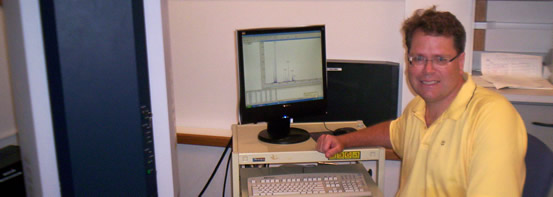
Steve Dunham uses the MALDI mass spectrometer to determine the mass of biomolecules. The MALDI uses a laser to blast large molecules into the gas phase.
Department Facilities
Laboratory Rooms: The
Chemistry Department is located on the second floor of Collier Hall of
Science. The department has four main teaching laboratories: General
Chem, Organic Chem, Analytical Chemistry, and Physical
Chemistry. The General Chemistry lab has space for 20 students;
the rest have maxima of 16 or fewer. There are three main
laboratories for chemical instrumentation, and six research labs for
undergraduate students.
Instruments: The Department has a suite of modern chemical
instruments. By the end of the sophomore year, students
have gained hands-on experience with the GC-MS, the NMR, the FTIR, the
Ocean Optics spectrmeters, and the Vernier pH and temperature probes.
Mass Spectroscopy: a Shimadzu GC-MS, a Bruker MALDI
mass spec.
Photon spectroscopy: a Varian 200 MHz NMR, a
Nicolet FTIR, a Perkin-Elmer Atomic Absorption spectrometer, several
different UV-VIS absorption spectrometers, a a suite of versatile Ocean
Optics spectrometers, a laser Raman spectrometer, a Horiba fluorimeter,
a Rudolph polarimeter.
Other instruments: More than 30 laptop computers,
Vernier probes and software for lab measurements using labtops, EDaq
electroanalytical instrumentation, one SRI gas chromatograph, a
Shimadzu HPLC system, a Parr bomb/solution calorimeter, centrifuge,
electrophoresis equipment.
A National Science Foundation Instructional Laboratory Instrumentation (NSF-ILI) grant made to the Moravian College Science Division in April 1993 provided funds for our gas chromatograph/mass spectrometer and a unique electronic instrumentation network that facilitates the use of science division instruments in teaching and research laboratories across the science division. The Moravian College Scientific Instrumentation Network (MOCOSIN) links all division instrumentation with Sun, Macintosh, and PC workstations, and file servers to allow efficient "off-line" analysis of instrumental data. MOCOSIN has allowed all science departments to expand their use of top line instruments in introductory and intermediate level courses. Another NSF-ILI grant received by the Chemistry Department in May of 1995 allowed the purchase of laser fluorescence equipment that is used in physical chemistry and physics courses as well as undergraduate research projects in chemistry and physics.




